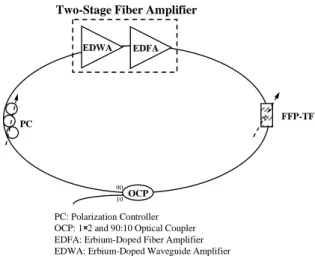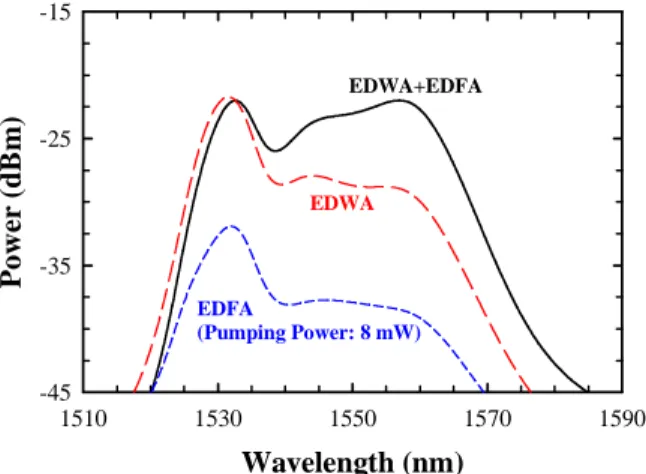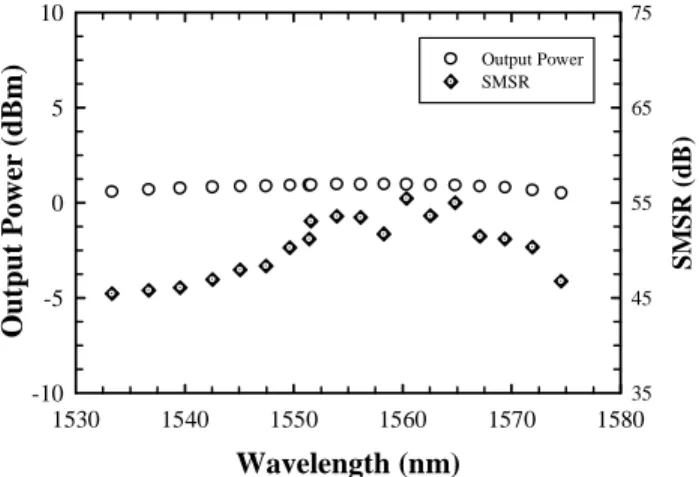A tunable erbium-doped fiber ring laser with
power-equalized output
Chien-Hung Yeh*
* Information and Communications Research Laboratories, Industrial Technology Research Institute, Chutung, Hsinchu 310-40, Taiwan
depew@itri.org.tw
Ming-Ching Lin
Department of Photonics & Institute of Electro-Optical Engineering, National Chiao Tung University, Hsinchu 300-10, Taiwan
Sien Chi
Department of Photonics & Institute of Electro-Optical Engineering, National Chiao Tung University, Hsinchu 300-10, Taiwan
Department of Electrical Engineering, Yuan Ze University, Chung-Li 320-03, Taiwan Abstract: We propose and demonstrate a tunable erbium-based fiber ring
laser with power-equalized output. When a mode-restricting intracavity fiber Fabry-Perot tunable filter (FFP-TF) is combined, the proposed resonator can guarantee a tunable laser oscillation. This proposed laser can obtain the flatter lasing wavelength in an effectively operating range of 1533.3 to 1574.6 nm without any other operating mechanism. Moreover, the performances of the output power, wavelength tuning range, and side-mode suppression ratio (SMSR) were studied.
©2006 Optical Society of America
OCIS codes: (140.4480) Optical amplifiers; (060.2320) Fiber optics amplifiers and oscillators References and links
1. S. K. Liaw, C. C. Lee, K. P. Ho and S. Chi, “Power equalized wavelength-selective fiber lasers using fiber Bragg gratings,” Opt. Commun. 155, 255–259 (1998).
2. Y. Shi, M. Sejka and O. Poulsen, “A unidirectional Er-doped fiber ring laser without isolator,” IEEE Photonics Technol. Lett. 7, 290-292 (1995).
3. W. H. Loh, B. N. Samson, L. Dong, G. J. Cowle, and K. Hsu, “High performance single frequency fiber grating-based Erbium: Yt-terbium-codoped fiber lasers,” J. Lightwave Technol. 16, 114-118 (1996). 4. A. Cucinotta, S. Selleri, L. Vincetti, and M. Zoboli, “Numerical and experimental analysis of erbium-doped
fiber amplifier liner cavity lasers,” Opt. Commun. 156, 264–270 (1998).
5. C. H. Yeh, C. C. Lee, C. Y. Chen and S. Chi, “A Tunable S-Band Erbium-Doped Fiber Ring Laser,” IEEE Photonics Technol. Lett. 15, 1053-1054 (2003).
6. S. Yamashita and M. Nishihara, “Widely erbium-doped fiber ring laser covering both C-band and L-band,” IEEE J. Sel. Top. Quantum Electron. 7, 41-43 (2001).
7. O. Graydon, W. H. Loh, R. I. Laming, and L. Dong, “Triple frequency operation of an Er-doped twincore loop laser,” IEEE Photon. Technol. Lett. 8, 63-65 (1996).
8. H. Y. Tseng, S. K. Liaw, and S. Chi, “Power-equalized parallel-type pump-shared fiber lasers based on parameter-adjustment,” Opt. Commun. 170, 229–234 (1999).
9. C.-H. Yeh, M.-C. Lin and S. Chi, “Gain flattened erbium-doped amplifier with 34 nm flat bandwidth,” Electron. Lett. 42, 1086-1088 (2006).
1. Introduction
Fiber lasers have been extensively investigated for many important applications, both in digital and analog transmission systems [1], laser spectroscopy, fiber-optic sensors [2], optical signal processing and wavelength conversion, etc. To increase the information capacity using wavelength division multiplexed (WDM) transmission, the realization of stable, narrow
#75762 - $15.00 USD Received 3 October 2006; revised 13 November 2006; accepted 13 November 2006
linewidth and equal output power lasers in the 1.48 to 1.62 μm band have been extensively developed [3]-[6]. With the advantage of wavelength insensitivity to temperature over semiconductor lasers at least in an order of magnitude, tunable wideband erbium-doped fiber (EDF) laser is a promising candidate for WDM communications [7]. Recently, the power-equalized EDF ring lasers by varying the pumping power or using optical filter were also investigated [5], [8].
In this paper, we demonstrate a tunable fiber ring laser based on a flattening amplified spontaneous emission (ASE) source by the proposed erbium-based fiber amplifier to obtain power-equalized output without any external operation. When a mode-restricting intracavity fiber Fabry-Perot tunable filter (FFP-TF) is combined, the proposed resonator can guarantee a tunable laser oscillation. Moreover, the performances of the output power, wavelength tuning range, and side-mode suppression ratio (SMSR) are also studied.
2. Experiment and discussion
Figure 1 shows the tunable fiber ring laser configuration based on a two-stage erbium-based fiber amplifier (EBFA) to generate the power-equalized outputs. The proposed fiber laser constructs by a two-stage EBFA, a fiber Fabry-Perot tunable filter (FFP-TF), a polarization controller, and a 1×2 and 10:90 optical coupler (OCP). The proposed EBFA consists of an erbium-doped waveguide amplifier (EDWA) and a cascaded erbium-doped fiber amplifier (EDFA). The PC is used to align the state of polarization of the ring cavity to guarantee a stable oscillation. A FFP-TF is an all-fiber device having a widely tunable range, low insertion loss of < 0.5 dB, and low polarization-dependent loss of ~0.1 dB. The 3 dB bandwidth and finesse of FFP-TF were 0.4 nm and 100. The tuning speed of the FFP-TF was about 200 ms. This FFP-TF having the free spectral range (FSR) of 44 nm can provide wavelength selection in the ring laser cavity by controlling the external voltage (0 to 12 V) on the piezoelectric transducer (PZT) of this filter. That is to say, the filter has 44 nm tuning range. In addition, an optical spectrum analyzer (OSA) with a 0.05 nm resolution is used to measure and observe the output spectra of ring laser.
EDFA EDWA
Two-Stage Fiber Amplifier
OCP 90 10 FFP-TF PC PC: Polarization Controller
OCP: 1×2 and 90:10 Optical Coupler
EDFA: Erbium-Doped Fiber Amplifier EDWA: Erbium-Doped Waveguide Amplifier
Fig. 1. Experimental setup of an erbium-based fiber laser with tunable power-equalized output.
First, we generate a larger and flatter ASE source using the proposed EBFA (an EDWA and a cascaded EDFA). The first EDWA stage, which is manufactured via two-step ion-exchange process, has the advantage of inheriting the known properties of the EDFA, such as low noise figure, slight polarization dependence, and no crosstalk between WDM channels. All optical performances are measured when the laser pump diode current equals to 440 mA at ambient temperature. The second EDFA stage consists of a 10 m long EDF, a 980 nm pump laser of 8 mW, a 980/1550 nm WDM coupler and an optical isolator (OIS). Thus, the ASE
#75762 - $15.00 USD Received 3 October 2006; revised 13 November 2006; accepted 13 November 2006
spectra of the EDWA, EDFA and EBFA are shown in Fig. 2, respectively. The medium dash line presents the ASE of EDWA and the short dash line shows the ASE of EDFA. When the two erbium amplifiers are cascaded in serial, the two-stage amplifier can obtain a larger and flatter ASE profile (solid line) compared with common EDFA’s, as shown in Fig. 2. In Fig. 2, a maximum power level variation of ASE is nearly 3.4 dB in the wavelength range from 1530 to 1560 nm. The two-stage gain-flattened EDFA module was discussion in Ref. 9. Based on the proposed amplifier, the entire gain were large than 35 dB and the maximal gain variation of ±1.1 dB was retrieved, for −25 dBm input saturation power, in an operating range of 1528 to 1562 nm. The operating mechanism of gain flattening was that the EDWA and EDFA have complementary spectroscopy and the gain saturation effect to achieve the gain flattening [9]. Compared with EDWA or EDFA used, the two-stage amplifier shows a larger and flatter ASE output over the wavelengths of 1530 to 1560 nm. Therefore, due to the larger and flatter ASE power based on the proposed amplifier in ring laser scheme, it can retrieve the larger and constant output power levels in an effectively operating range.
EDWA+EDFA Wavelength (nm) 1510 1530 1550 1570 1590 Pow er ( d B m ) -45 -35 -25 -15 EDWA EDFA (Pumping Power: 8 mW)
Fig. 2. The ASE spectra of the EDWA, EDFA and proposed two-stage erbium-based amplifier, respectively. Wavelength (nm) 1530 1540 1550 1560 1570 1580 O u tput Power ( d Bm ) -60 -40 -20 0 20
Fig. 3. Optical spectra of the ring laser while the various external voltages applied on the PZT of FFP-TF in the tuning range of 1533.3 to 1574.6 nm.
Figure 3 shows the optical spectra of the power-equalized EDF-based ring laser when the various external voltages applied on the PZT of FFP-TF. And, the tuning range of our proposed ring laser over 41.3 nm from 1533.3 to 1574.6 nm is observed. Figure 4 represents
#75762 - $15.00 USD Received 3 October 2006; revised 13 November 2006; accepted 13 November 2006
the output power and SMSR versus the tuning wavelength in this fiber ring laser. The maximal and minimal output powers are 1 and 0.5 dBm at 1554 and 1574.6 nm, as seen in Fig. 4. The maximum output power variation of the laser is below 0.5 dB in the tuning range of 1533.3 to 1574.6 nm, and the maximum and minimum SMSRs are 55.5 and 45.5 dB. In an operating range of 1536.7 to 1571.9 nm, the power variation is less than 0.3 dB and the SMSR is larger than 45.8 dB. To obtain the constant output power, the additional method in fiber laser, which controls the pumping power or uses the optical filter, was usually used. In our proposed laser scheme, it can complete the equalized-power output without additional operation. Comparisons of the proposed ring laser and the past studies [5], [6], the proposed laser not only guarantee the larger and equalized power outputs but also retrieve the higher SMSRs. As a result, the proposed fiber laser can retrieve a larger output power and a flatter lasing bandwidth without any other operating mechanism.
Wavelength (nm) 1530 1540 1550 1560 1570 1580 O u tput Pow er ( d Bm ) -10 -5 0 5 10 SM SR (dB ) 35 45 55 65 75 Output Power SMSR
Fig. 4. Output power and SMSR versus the tuning wavelength in this ring laser.
4. Conclusion
In summary, we have proposed and demonstrated experimentally a tunable power-equalized erbium-based fiber laser based on an EDWA cascading an EDFA in serial.When a mode-restricting intracavity fiber Fabry-Perot tunable filter (FFP-TF) is combined, the proposed resonator can guarantee a tunable laser oscillation. Output power of > 0.3 dBm, maximum power variation of < 0.5 dB, and side-mode suppression ratio of > 45.5 dB has been experimentally demonstrated for this fiber laser over an operating range of 1533.3 to 1574.6 nm.
Acknowledgment
This work was supported in part by the National Science Council (NSC) of Taiwan (ROC) under grants NSC 95-2221-E-155-059 and NSC 95-2221-E-155-072.
#75762 - $15.00 USD Received 3 October 2006; revised 13 November 2006; accepted 13 November 2006


